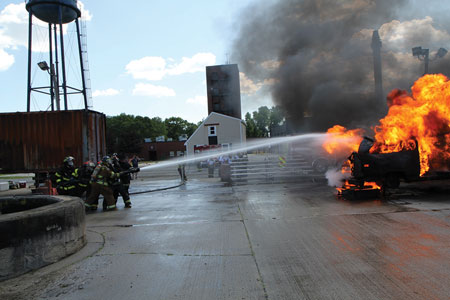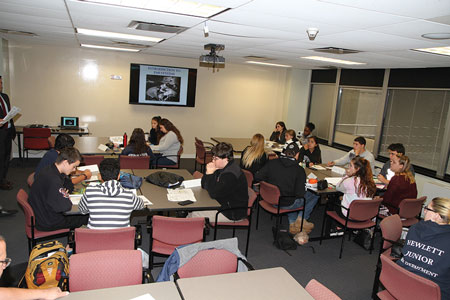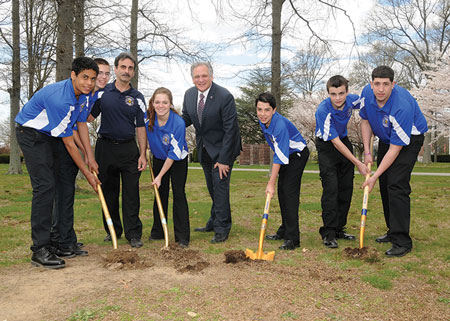
Scenario: Take 45 young men and women between the ages of 14 and 18 from 22 countywide fire department Junior Firefighter/Explorer programs, bring them together for five days/seven hours a day during one of the hottest weeks of the year, and put them through challenging firefighter scenarios in full bunker gear and self-contained breathing apparatus (SCBA), and you have Camp Fahrenheit 516.
In July 2016, the Nassau County (NY) Junior Firefighter Association (NCJFA) did just that for the second straight year. The NCJFA’s Board of Directors met with the chiefs and staff of the Nassau County Fire Service Academy [FSA, a division of the Nassau County Vocational Education and Extension Board (VEEB)] and, recognizing the natural relationship, planned this extraordinary event.
History and Mission
The NCJFA was formed in January 2006. Since its inception, it has taken annual field trips to the FSA since 2009 (although this did not include actual hands-on, live-burn training). It has successfully completed four certified first responder emergency medical services programs sponsored by VEEB and the Northwell Health Systems, which has awarded eight educational scholarships to its members. The National Volunteer Fire Council recognized the Association as the only organization in the country for junior firefighters. This recognition was based on the NCJFA’s need to travel great distances for its summer camps; its dedication to staying current in firefighting concepts by inviting fire service leaders to speak at its monthly meetings; and the organization and development of a proactive, fully functioning firematic entity.
 |
| (1) Students perform a car fire evolution at Camp Fahrenheit 516. (Photos by Jerry Presta.) |
The NCJFA’s ethos is to bring together all Nassau County junior firefighters to form a comradery of friendship; to train, play, and grow together; and to offer the best training and education to the firefighting youth of Nassau County. It is that last credo that allowed the following events to be set in motion.
Curriculum and Schedule
Rather than travel more than five hours to attend similarly organized types of camps in other states, as it had done since 2005, the NCJFA approached the FSA to use its state-of-the-art Class A burn facilities located in Nassau’s own backyard. For five days, from 0900 hours to 1600 hours, the young future firefighters of Nassau County were groomed for the position as they participated in evolutions on donning and doffing personal protective equipment (PPE) and SCBA; portable ground ladders; search procedures; ropes and knots; forcible entry and hand tools; advanced mask confidence training and emergency procedures; hoseline selection, placement, and operations; commercial building fire evolutions; and vehicle fires.
The specialized curriculum was designed by the FSA’s former Chief John Brown and the current Chief of Training Robert Hughes along with Hughes’s new Assistant Chief Paul Wilders. The FSA chiefs, together with the NCJFA’s training committee, settled on the terminal objectives to provide a fun, worthwhile, and educational real-life experience for the young attendees in safe, supervised, live-fire training scenarios. By all accounts, the objectives were well surpassed. In fact, on the last day of the camp, the participants completed an evaluation to describe their overall experiences. Even with week-long outdoor temperatures above 90°F and high humidity, the overwhelming sentiment of the junior firefighters was, “The camp was too short!” This positive response was a testament to what was planned by the FSA and NCJFA training committees.
 |
| (2) Nassau County Juniors from 13 departments take their 4th Certified First Responders Certification course. |
Although many Junior Firefighter/Explorer participants had handled hoses, worn firefighting gear, and had some introduction to fire science and firefighting from their own departments, very few had any live-fire training experience or participated in team-building exercises as laid out in the Camp Fahrenheit 516 curriculum.
Camp Fahrenheit 516’s curriculum and busy schedule as well as the hot, humid weather were challenging for participants, but they were overcome by the enthusiasm, excitement, and empowerment of the program; even the FSA instructors enjoyed their time together with Nassau’s firefighters of tomorrow.
Following is a sample of the daily routine fashioned from the FSA summer combination classes for the county’s probationary firefighters, which provides two weeks of classroom and hands-on training that meet the New York State Office of Fire Prevention and Control’s Essentials of Firefighting and Firefighter 1 requirements:
- Day 1. Sign in, curriculum overview, staff expectations, and daily schedule followed by morning lectures on safety and procedures. After lunch, the students started with a “two-minute” donning exercise drill with PPE and SCBA. Then, students went through a blacked-out maze on air for a dry run and familiarization with the SCBA. The day concluded with partnered searches in a simulated smoke environment using theatrical smoke machines.
- Day 2. After meeting for the two-minute SCBA donning drill (which is held at the start of each day), the juniors then learned about fire behavior and classifications. Next, they practiced their two-minute drills again, followed by right- and left-handed searches, low-profiling maneuvers, emergency escape and entrapment, confined space maneuvers, emergency escape procedures, and team search techniques.
- Day 3. After the two-minute SCBA drills (in which the participants and instructors began to see a marked improvement), the juniors learned about hand and power tools; traditional forcible entry techniques; and lectures on ventilation, overhaul, and fire extinguishers. The afternoon portion of the camp included putting this knowledge into practice, which included forcing doors, working “through the lock,” overhauling with hooks and hand tools, using power saws, and extinguishing Class A and B fires with hand-held extinguishers. Additionally – for 2016 – each participant received instruction and participated in hands-on evolutions in the personal alert safety system “bailout” procedures from the second floor of a private dwelling.
- Day 4. After another round of two-minute donning drills and basic hoseline evolutions, the juniors were treated to a first-hand look at raging fires up close. They attended a session in the fire behavior lab and extinguished real fires using handlines. The day ended with instruction on ground ladders.
- Day 5. On their last day of camp, participants received classes on fire department knots and vehicle fires. After lunch, the juniors put this knowledge to use as they fought vehicle fires and tied knots on hoses and tools.
As the second-annual Camp Fahrenheit 516 came to an end, we discussed the opportunities for bigger and better options for the camp. Formulating this experience was five years in the making; and for two consecutive years, it provided the future of Nassau County’s volunteer fire service with invaluable experiences as well as practical firefighting lessons to enhance their future training.
Our Vision
The vision of the NCJFA’s Camp Fahrenheit 516 was in the planning stages for nearly 18 months. No one else in this area could emulate this opportunity and exposure to the fire service for the participants. As a result, a natural relationship had been forged. This highly specialized summer camp is now an annual event that will continue for years to come. The FSA staff and NCJFA’s training committee will revise and enhance the curriculum to provide the best training and camp experience for this diverse group of motivated individuals.
 |
| (3) Groundbreaking for the Nassau County Junior Firefighter’s Monument in April 2015. |
The NCJFA’s “crown jewel” came on May 15, 2016, when it, along with Nassau County Executive Edward Mangano, unveiled a stone monument in Nassau’s Eisenhower Park dedicated to every Junior and Explorer firefighter in the county. This dedication was in the works for more than a year and included raising funds, selecting the artwork, and having the monument cast.
For more information, visit the NCJFA’s Web site at www.ncjfa.org and click on “Fire Camp.”
Authors’ note: Special thanks to the many individuals and organizations that help make this program a reality including the Nassau County VEEB; Nassau County FSA; the Boy Scouts of America; Port Jefferson Sports; Nassau County’s Fifth Battalion Softball League; the East Norwich, East Farmingdale, Farmingdale, Floral Park (FPVFD), Hicksville, Massapequa, and Rockville Centre, New York, volunteer fire departments; former FPVFD Chief Brian Naughton; and the Nassau County Firematic Organizations.
JERRY PRESTA is a 20-year firefighter/emergency medical technician as well as a junior firefighter advisor for the East Norwich (NY) Volunteer Fire Department (ENVFD). He is also a chairman for the Nassau County (NY) Junior Firefighters Association/Junior Board, the Nassau County Fireman’s Association Junior/Explorer, and the Southern New York Youth Committee. Presta is vice-chairman of the Fireman’s Association of the State of New York Youth in the Fire Service Committee. He is a National Volunteer Fire Council advisory board member.
STEPHEN MARSAR, MA, EFO, is a 26-year veteran and battalion chief in the Fire Department of New York (FDNY). He is a former chief and commissioner of the Bellmore (NY) Volunteer Fire Department. Marsar is a certified FDNY IMT National and a New York State fire instructor level II, a Department of Health Regional faculty member, and a certified instructor coordinator. He is an adjunct professor at Nassau (NY) Community College and serves as a chief instructor for the FDNY and the Nassau County Fire Service and EMS Academies. He has a master’s degree in homeland security and defense from the Naval Postgraduate School and a bachelor’s degree in fire science and emergency services administration from Empire State College. He is a graduate of the Executive Fire Officer Program at the National Fire Academy, a Roll of Honor inductee, and a two-time winner of FEMA’s National Outstanding Research Award. Marsar is an advisory board member of Fire Engineering and FireRescue magazines.
Recruitment + Training = Retention
Tactics for Today’s Recruitment & Retention
Rethinking Recruitment and Retention for the Volunteer Fire Department
Fire Engineering Archives

